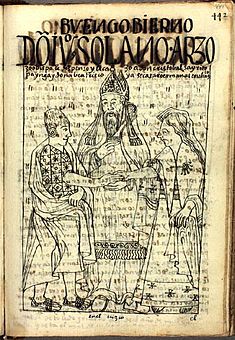Juan Solano facts for kids
Quick facts for kids The Right Rev. Lord Brother Juan Solano, O.P. |
|
|---|---|
| Bishop Emeritus of Cuzco | |

Solano sealing the marriage of Sayri Túpac (from the Nueva Corónica y Buen Gobierno by Felipe Guaman Poma de Ayala)
|
|
| Province | Seville (1544–1546); Lima (1546–1562) |
| See | Cuzco |
| In Office | 29 February 1544–1562 |
| Predecessor | Vincente de Valverde y Alvarez de Toledo, O.P. |
| Successor | Francisco Ramírez |
| Orders | |
| Ordination | c. 1530 |
| Consecration | 24 October 1546 by Archbishop Jerónimo de Loayza, O.P. |
| Personal details | |
| Born | c. 1505 Archidona, Málaga, Crown of Castile |
| Died | 14 January 1580 Rome, Papal States |
| Buried | Basilica of Santa Maria sopra Minerva, Rome, Italy |
Juan Solano (around 1505 – 1580) was a Spanish missionary. He belonged to the Dominican Order, a group of Catholic priests. He became the second Catholic bishop of Cuzco, Peru. He served in this important role from 1544 to 1562.
Contents
Early Life and Education
Juan Solano was born in a town called Archidona in Spain. This was around the year 1504. He went to the University of Salamanca to study. While there, he decided to join the Dominican Order. He started his training to become a Dominican priest in late 1524. He made his final promises to the order on December 24, 1525. Later, Solano held several positions. He even became the leader, or prior, of a monastery in Peñafiel.
Journey to Peru and Becoming Bishop
In September 1543, Emperor Charles V chose Solano to be the second Bishop of Cuzco. Solano did not wait for the Pope's official approval. He also was not yet made a bishop. Instead, he quickly sailed to Peru with the Viceroy Blasco Núñez Vela. A Viceroy was like a governor who ruled a colony for the king.
They left Spain on November 3, 1543. They arrived in Panama on January 10, 1544. Solano then sailed from Panama on January 24, 1544. He landed in Tumbes, Peru on March 4. From there, he traveled by land to Lima.
Challenges and Loyalty to the King
When Solano arrived in Peru, there was a big rebellion. Gonzalo Pizarro led this uprising. Because of the fighting, Solano could not enter Cuzco. He could not take his place as bishop right away. Instead, he joined the king's army.
He finally entered Cuzco on November 3, 1545. He was officially made a bishop on October 24, 1546. Another Dominican priest, Jerónimo de Loayza, made him a bishop. Loayza was the new Archbishop of Lima. However, Solano was forced out of Cuzco again. This happened after the Battle of Huarina in 1547.
Solano was very loyal to the king. This made the rebel leader Francisco de Carvajal angry. Carvajal said that Solano, "having sat in his church and prayed for peace among Christians, walked around the camp like a field marshal." After the defeat at Huarina, Solano joined the forces of Pedro de la Gasca. He was present at the Battle of Jaquijahuana. This battle ended the rebellion. The king's side won.
Work as Bishop in Cuzco
As bishop, Solano worked hard to protect the rights of the native people of Peru. He collected money from the Spanish conquistadores. These were the conquerors who had won battles. He used this money to help the suffering native population. With the funds, he built the Hospital de San Lázaro. This hospital was finished in 1552. It was the first hospital of its kind in Peru.
During his time as bishop, work also began on the main church in Cuzco. This is the current Cathedral of Cuzco. He also helped make other bishops. He was the main person who made García Díaz Arias the first Bishop of Quito in 1547. He also helped make Martín de Calatayud the third Bishop of Santa Marta in 1547.
Later Life and Legacy
Solano went back to Spain in October 1560. He wanted to get support to control the behavior of the conquerors. He also wanted his large diocese to be divided. He thought it was too big for one bishop. When he failed in Spain, he went to Rome. He hoped to get Pope Pius IV interested in his ideas. He failed again and resigned as bishop in 1562.
Solano retired to a Dominican convent in Rome. It was called Santa Maria sopra Minerva. In his later years, he helped change the convent's school. He wanted it to be like a famous college in Spain. He left all his money to this new school. It was called the College of St. Thomas. This college later became the Pontifical University of Saint Thomas Aquinas. Many people call it the Angelicum.
Juan Solano died in Rome on February 19, 1580.
Images for kids
-
Solano sealing the marriage of Sayri Túpac (from the Nueva Corónica y Buen Gobierno by Felipe Guaman Poma de Ayala)
See also



